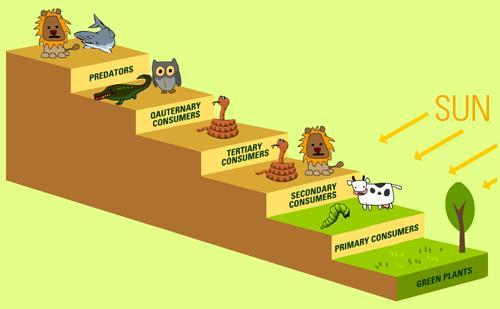
In every food chain green plants are
A. Decomposers
B. Producers
C. Consumers
D. None of the above
Answer
473.7k+ views
Hint: We have to remember that a food chain is a linear network of connections from producer organisms to apex predator species, detritivores, or decomposer species in a food web. A food chain also reveals how the food they consume binds the species with each other. A different trophic level reflects each level of a food chain.
Complete answer: As we know that a decomposer is an entity, such as the remnants of dead animals, that decomposes or breaks down organic material. Bacteria and fungi contain decomposers. These species carry out the decomposition process that, after death, all living organisms undergo.
We have to know that the consumers are animals that require food to be eaten (i.e. consumed) to get their energy. These species are referred to as heterotrophs, meaning that something else (hetero) must be consumed as food.
Organisms that make their own feed are producers; they are also classified as autotrophs. They receive energy from chemicals or the light, and they turn the energy into usable energy in the form of sugar or food with the aid of water. Plants are the most common example of a manufacturer.
Green plants, small shrubs, berries, phytoplankton, and algae are some examples of producers within the food chain.
So, the correct answer is “Option B”.

Note:
The food chain is the order in which, in order to live, animals and plants consume each other. Each living creature requires other creatures below it to feed. Depending on which animals and plants live there, every ecosystem has a different food chain. Plants are the smallest component of the food chain. They are called farmers because, using the energy of sunlight, they produce their own food. Photosynthesis is called this process. The customers of the food chain are livestock. They consume other plants and animals.
Complete answer: As we know that a decomposer is an entity, such as the remnants of dead animals, that decomposes or breaks down organic material. Bacteria and fungi contain decomposers. These species carry out the decomposition process that, after death, all living organisms undergo.
We have to know that the consumers are animals that require food to be eaten (i.e. consumed) to get their energy. These species are referred to as heterotrophs, meaning that something else (hetero) must be consumed as food.
Organisms that make their own feed are producers; they are also classified as autotrophs. They receive energy from chemicals or the light, and they turn the energy into usable energy in the form of sugar or food with the aid of water. Plants are the most common example of a manufacturer.
Green plants, small shrubs, berries, phytoplankton, and algae are some examples of producers within the food chain.
So, the correct answer is “Option B”.

Note:
The food chain is the order in which, in order to live, animals and plants consume each other. Each living creature requires other creatures below it to feed. Depending on which animals and plants live there, every ecosystem has a different food chain. Plants are the smallest component of the food chain. They are called farmers because, using the energy of sunlight, they produce their own food. Photosynthesis is called this process. The customers of the food chain are livestock. They consume other plants and animals.
Recently Updated Pages
The correct geometry and hybridization for XeF4 are class 11 chemistry CBSE

Water softening by Clarks process uses ACalcium bicarbonate class 11 chemistry CBSE

With reference to graphite and diamond which of the class 11 chemistry CBSE

A certain household has consumed 250 units of energy class 11 physics CBSE

The lightest metal known is A beryllium B lithium C class 11 chemistry CBSE

What is the formula mass of the iodine molecule class 11 chemistry CBSE

Trending doubts
Is Cellular respiration an Oxidation or Reduction class 11 chemistry CBSE

In electron dot structure the valence shell electrons class 11 chemistry CBSE

What is the Pitti Island famous for ABird Sanctuary class 11 social science CBSE

State the laws of reflection of light

One Metric ton is equal to kg A 10000 B 1000 C 100 class 11 physics CBSE

Difference Between Prokaryotic Cells and Eukaryotic Cells




